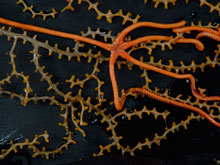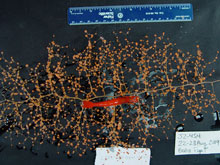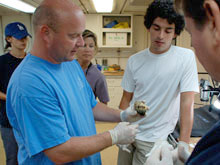
A collected specimen of brittle star, Asteroschema, with a parmuricid coral. Click image for larger view and image credit.
Deepwater Corals: What's the Big Deal?
August 24, 2009
Timothy Shank
Evolutionary Biologist
Woods Hole Oceanographic Institution
![]() This ophiuriod brittle star, Asteroschema, lives in close association with a parmuricid coral.
This ophiuriod brittle star, Asteroschema, lives in close association with a parmuricid coral.
Deepwater corals are many things, including fascinating, diverse, slow-growing, threatened, and susceptible to deep-sea fisheries and mining activities. Yet they have another very important quality: the ability to harbor, or play home to, a broad array of associated animals. Some estimate that as many as 1,300 species, including commercially important species, live among deepwater corals. This ability to provide habitat for other species makes deepwater corals of immediate interest to conservationists, commercial fisheries, resource managers,and scientists.

A collected deep-sea shrimp (Bathypalaemonella) with soft coral (Chrysogorgia). Click image for larger view and image credit.
Coral-Invertebrate Associations Are Important
Scientists have known for a long time that certain species of crabs, brittle stars, worms, and shrimp live around or are “associated with” deepwater corals. Only recently have we learned just how specific these coral-invertebrate associations can be. One example we have seen on this cruise is the species of octocoral that hosts only a single brittle star species, and then only a single individual at a time (![]() see video). We have also seen shrimp with a baseball-bat-like arm that live among the interconnected branches of a specific species of soft coral (
see video). We have also seen shrimp with a baseball-bat-like arm that live among the interconnected branches of a specific species of soft coral (![]() see video). And then there is the ultimate host-associate relationship, one we’ve seen in the North Atlantic and may possibly see here in the Gulf of Mexico: a small polychaete worm that lives only on a single type of fan-shaped octocoral. This coral has modified its sclerites (a characteristic structure of the skeleton) to form tunnels that serve as homes for more than 300 individuals per a single coral.
see video). And then there is the ultimate host-associate relationship, one we’ve seen in the North Atlantic and may possibly see here in the Gulf of Mexico: a small polychaete worm that lives only on a single type of fan-shaped octocoral. This coral has modified its sclerites (a characteristic structure of the skeleton) to form tunnels that serve as homes for more than 300 individuals per a single coral.
These highly specific relationships have led to fundamental questions about how these invertebrates living on corals disperse and locate their coral host. How have these specific relationships formed? And how might the diversity of sea life be affected if the coral habitats are lost to fisheries and other activities?

Tim Shank discusses a seafloor specimen with other members of the science party. Click image for larger view and image credit.
Cold-water Corals Provide Critical Habitats
So what’s so important about deepwater corals? Cold-water corals provide critical if not essential habitats that support a diversity of species, including highly intimate relationships we are only beginning to understand. With this arises a problem. Corals appear to colonize areas and grow very slowly (some corals may be over 4,000 years old), and disturbance, like mining, fishing, and abrupt chemical changes in these areas may not only wipe out large stands of fragile corals, but also the diversity of species living on them. Without these corals as homes for other species, the future of the associated species is also threatened. Conservation managers around the world are trying to manage and protect coral areas, hoping to stem the loss of this biodiversity. It is our goal to provide important insights into how these associations are maintained through dispersal and genetic connectivity, so that we can help guide management and protection of these valuable resources in our deep ocean.



























